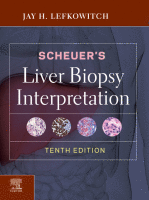Physical Address
304 North Cardinal St.
Dorchester Center, MA 02124

You’re Reading a Preview Become a Clinical Tree membership for Full access and enjoy Unlimited articles Become membership If you are a member. Log in here

Introduction This chapter will focus primarily on the role of transmission electron microscopy (TEM) in the assessment of liver ultrastructure and disease. It also describes, in brief, the principles and uses of other methodologies. The special conditions required for tissue…

Introduction The pathologist is often asked to examine liver biopsies obtained to evaluate liver dysfunction in transplant patients, including recipients of liver, renal and bone marrow grafts. For liver transplantation, liver biopsy remains the diagnostic ‘gold standard’ when jaundice and…

Introduction Liver biopsies are often obtained to evaluate abnormalities of liver function tests in patients with known or suspected systemic disease and in the investigation of pyrexia of unknown origin. In the latter, liver biopsy provides diagnostic information in approximately…

Wilson’s disease (hepatolenticular degeneration) Wilson’s disease is an autosomal recessive disorder due to mutations in the gene ATP7B for copper-transporting ATPase located in the trans -Golgi network of the liver. It is uncommon but important and treatable. Normal hepatic copper…

Introduction Paediatric liver biopsies present a unique set of diagnostic problems for the pathologist, many of which become clinically apparent in the first few months of life as neonatal cholestasis . Among the important disorders one must consider in evaluating…

The hepatic arteries The effects of occlusion of hepatic artery branches are unpredictable because of the liver’s double blood supply and variable collateral flow. Potential effects of thrombotic or other occlusion include infarction and ischaemic damage to the biliary tree…

Introduction This chapter is intended to provide a working overview of the tumours and tumour-like nodular lesions that the pathologist will encounter with some frequency in everyday practice. The majority of these can be classified according to the putative cells…

Introduction Cirrhosis is a diffuse process in which the normal lobules are replaced by architecturally abnormal nodules separated by fibrous tissue. The nodules, which are most commonly the result of regenerative hyperplasia following hepatocellular injury, are functionally less efficient than…

Definition and causes Chronic hepatitis is a common reason for persistently abnormal liver function tests and forms the background for the development of much cirrhosis and hepatocellular carcinoma. It is defined as persistence of liver injury with raised aminotransferase levels…